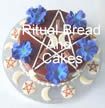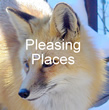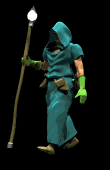|
Moden Druidic Movements Order of Bards, ovates and Druids (OBOD): the re are twobeliefs concerning the development of this group. One traces their origin to the ancient oder of Druids (AOD) by henry Hurle in England in 1781. This group repeatedly spit due to internal dissension ito many separate organizations. By 1918, there were five groups attemping to perform solstice ceremonies at Stone henge; all were breakaway groups from the original ancient order of druids. By 1955, all had disappeard except for the British Circle of universal Bond which subsequently split in 1963 to form the OBOD. The other lineage is claimed by the OBOD who trace thier ancestry back through the Aod to a group founded inEngland in 1717 by John Toland. He is said to have combined local groups of druids (called grovws) from 10 locations in to the Mother Grove. The OBOD currant address is: PO Box 1333, Lewes, East Sussex, England, BN7 3ZG Email address office@0bod.co.uk
The Druid and Celt Religion and CultureDruids believe in the eternal nature of the Soul and see a living spirit in all forms of creation. There is an ancient saying attributed to the Druids "Spirit sleeps in the mineral breathes in the vegetable dreams in the animal and wakes in man." Druids hold that souls could be contacted after death and that souls reincarnate. The universe is the Druid's living bible written directly by the hand of God. Moreover mankind is seen as evolving and unfolding in its awareness of itself. Within the spiritual makeup of creation is a pantheon of gods and goddesses as consciousness for the attributes in nature. Some of the most recognized are TARANIS -- the father of the gods associated with the oak tree; BELENOS -- the god of the Sun celebrated on Beltane or May Day; CERNUNNOS -- the horned god of the hunt who rules the dark side of the year (winter); LUGH -- the many-skilled; ESUS -- the pastoral god and magician; TEUTATIS -- the warrior god and ruler of the people; EPONA -- the horse goddess associated with fertility; MORRIGAN -- the goddess of war; CARIDWEN -- the mother goddess and triple goddess of fire water and air; RHEA -- the mistress of life and sovereign of time; and DIANA -- the huntress and goddess of the moon. The many gods and goddesses were known by many names depending on the region and period of time.
SAMHAIN
Samhain (pronounced 'sow'inn') is a very important date in the Pagan calendar for it marks the Feast of the Dead. Many Pagans also celebrate it as the old Celtic New Year (although some mark this at Imbolc). It is also celebrated by non-Pagans who call this festival Halloween. Samhain has been celebrated in Britain for centuries and has its origin in Pagan Celtic traditions. It was the time of year when the veils between this world and the Otherworld were believed to be at their thinnest: when the spirits of the dead could most readily mingle with the living once again. Later, when the festival was adopted by Christians, they celebrated it as All Hallows' Eve, followed by All Saints Day, though it still retained elements of remembering and honouring the dead. To most modern Pagans, while death is still the central theme of the festival this does not mean it is a morbid event. For Pagans, death is not a thing to be feared. Old age is valued for its wisdom and dying is accepted as a part of life as necessary and welcome as birth. While Pagans, like people of other faiths, always honour and show respect for their dead, this is particularly marked at Samhain. Loved ones who have recently died are remembered and their spirits often invited to join the living in the celebratory feast. It is also a time at which those born during the past year are formally welcomed into the community. As well as feasting, Pagans often celebrate Samahin with traditional games such as apple-dooking. Death also symbolises endings and Samhain is therefore not only a time for reflecting on mortality, but also on the passing of relationships, jobs and other significant changes in life. A time for taking stock of the past and coming to terms with it, in order to move on and look forward to the future. Ancient Celtic celebrationsNot only did the Celts believe the boundary between the worlds of the living and the dead dissolved on this night, they thought that the presence of the spirits helped their priests to make predictions about the future. To celebrate Samhain the Druids built huge sacred bonfires. People brought harvest food and sacrificed animals to share a communal dinner in celebration of the festival. During the celebration the Celts wore costumes - usually animal heads and skins. They would also try and tell each other's fortunes. After the festival they re-lit the fires in their homes from the sacred bonfire to help protect them, as well as keep them warm during the winter months.
The Winter SolsticeThe festival of Midwinter begins with the ceremonies of the winter solstice, the shortest day of the year and the longest night, when the power of darkness is honoured, the divine mother, the womb of creation. This is a specific astronomical moment and occurs anywhere between 20 - 23 December. Three days later, between 23 - 26 December, it is possible, without technological help, to see along the horizon that the sun is rising once more nearer to the east. This is the more traditional time of celebration. So, although Druids don't celebrate Christmas, the winter rites are held on and around the same days. Midwinter in the Druid tradition is called Alban Arthan, Welsh/Brythonic for 'the light of the bear'. For some it is understood to imply both the constellation of the Great Bear in our northern winter skies, and also Arthur, the saviour king and mythic hero of the British Isles. Historically a Christian Romano-British warrior king, Arthur fought the pagan Saxons, delaying their incursions into the Prettanic Isles for two more generations.. (Excerpt from Ritual by Emma Restall Orr)
IMBOLC
Is the festival that celebrates the beginning of spring, the first signs of life now beginning to emerge. Also spelled Imbolg, pronounced im-olk, or Oimelc in Gaelic, it is often known as Brighid's Day. In Welsh, it is Gwyl Forwyn, pronounced gwil vor-wun, the feast of the maiden, or Gwyn Fair, the feast of Mary, Brighid having the role equivalent to Mary, the divine mother, in pre-Christian Britain. Unlike Mary the perpetual virgin, however, Brighid evolves through the cycles of woman, and at this rite she is felt in her triplicity, as mother reflecting in the innocence of her child, as hag in the darkness of the womb's blood and ploughed earth. Candlemas is the same rite within the Christian tradition. Celebrated by the calendar between 1 - 2 February, for those who go by the seasons the festival comes when the first snowdrops are flowering, the first lambs are born, or when the energy of the earth can first truly be felt stirring. It is a festival which celebrates the mother who has given birth, the magical beauty of the mabon and all new life. . (Excerpt from Ritual by Emma Restall Orr)
The Spring EquinoxThe festival of the Spring Equinox, Alban Eilir, the sowing of seeds and the balance of day and nightThe Welsh/Brythonic name for this festival is Alban Eilir, meaning 'the light of spring', and it is the turning point within the season of Imbolc, marking the time of equal night and day when the sun rises in the east. By the calendar it is at a specific point around 21-22 March and a great many of its traditions have been taken on by the Christian Church and blended into Easter, a word that itself stems from the Saxon goddess Eostra, having the same root as oestrus and oestrogen. It is a festival of fertility waking. From here on the days become longer than the nights. The young sun god is taking up his weapons of manhood; the maiden of earth is shedding blood for the first time, moving forward through puberty, coy in her beauty, dressed in the golden flowers of springtime and sparkling rain. (Excerpt from Ritual by Emma Restall Orr)
BeltaneThe first festival of Summer, of Fertility, Pleasure and UnionsThe Irish Gaelic word, also spelled Belteinne or Bealteine, or in Scots Gaelic Bealtuinn, means 'bright or good fire', or 'fire of Bel', the old sun god whom Classical writers considered the same as their Apollo. In Welsh, it is Calan Mai, 'the Calends of May', and to those working by the calendar it is celebrated on 1 May. As Calan Mai is not deemed truly with us until the May tree or hawthorn has flowered, the rites may be adjusted to tie in with the opening of those sacred and beautiful white-pink blossoms. Calan Mai is the festival that marks the beginning of summer. Wrapped in a great deal of delicious and easily found folklore, it is a festival as popular as Calan Gaeaf, marking the other side of the year and exploring the other deep human drive that is fraught with taboos: sex. While at Alban Eilir the young couple's love was platonic, by Beltane they have grown to know the pleasures of sexuality. The festival is one which celebrates union. (Excerpt from Ritual by Emma Restall Orr)
The Summer SolsticeThe festival of the Summer Solstice and Midsummer, Alban Hefin, strength, light and the height of the sunAs with the festival that marks the mid point of winter, so the festival of midsummer is also divided into two. We begin with the celebrations of the summer solstice, which is at some specific point between 20 - 23 June. It takes three days here, too, before we can be certain simply by watching the horizon that the year has turned on its axis and the sun is rising further towards the east once more. This brings us to what is known as Midsummer's Day, between 23 - 26 June (usually thought of as 24 June). In Welsh/Brythonic, it is called Alban Hefin, meaning 'the light of summer'. In the Christian tradition, it is St John's Day and is especially important in some gnostic and mystic limbs of the faith. (Excerpt from Ritual by Emma Restall Orr)
LammasThe festival of Lammas, Lughnasadh, the first festival of harvestPronounced loo-nuh-sah in Gaelic, sometimes spelled Lughnasa, this festival is the feast of the sun god Lugh, he of the 'Skilful Hand', the Irish counterpart of the old British god Llew Llaw Gyffes who was equated by the Romans with their Mercury. In Saxon, the festival was called Hlaef-mass, meaning 'loaf mass', now Lammas, the celebration of the first sheaves of the harvest. In Welsh, it is Gwyl Awst, pronounced gwil oust, and translated as 'the feast of August', its traditional calendar date being the first of the month. For those who place the festivals by the cycle of nature, Gwyl Awst is celebrated with the first loaf made of the freshly harvested wheat. Of course, for our ancestors, immediately the harvest begins the hard work begins too. It is a time of community, of everyone giving everything they have in terms of time and energy to gather in the crops and get them to market. (Excerpt from Ritual by Emma Restall Orr)
The Autumn EquinoxMABON Autumn Equinox, around September 21, is thetime of the descent of the Goddess into theUnderworld. With her departure, we see thedecline of nature and the coming of winter.This is a classic, ancient mythos, seen theSumerian myth of Inanna and in the ancientGreek and Roman legends of Demeter andPersephone. In September, we also bid farewell to theHarvest Lord who was slain at Lammas. He isthe Green Man, seen as the cycle of nature inthe plant kingdom. He is harvested and hisseeds are planted into the Earth so that lifemay continue and be more abundant. Mabon ("Great Son") is a Welsh god. He was agreat hunter with a swift horse and a wonderfulhound. He may have been a mythologized actualleader. He was stolen from his mother, Modron(Great Mother),when he was three nights old,but was eventually rescued by King Arthur(other legends say he was rescued by theBlackbird, the Stag, the Owl, the Eagle, andthe Salmon). All along, however, Mabon hasbeen dwelling, a happy captive, in Modron'smagickal Otherworld -- Madron's womb. Only inthis way can he be reborn. Mabon's light hasbeen drawn into the Earth, gathering strengthand wisdom enough to become a new seed. Inthis sense, Mabon is the masculine counterpartof Persephone -- the male fertilizing principleseasonally withdrawn. Modron corresponds withDemeter. From the moment of the September Equinox, theSun's strength diminishes, until the moment ofWinter Solstice in December, when the Sun growsstronger and the days once again become longerthan the nights. Symbols celebrating the season include varioustypes of gourd and melons. Stalk can be tiedtogether symbolizing the Harvest Lord and thenset in a circle of gourds. A besom can beconstructed to symbolize the polarity of maleand female. The Harvest Lord is oftensymbolized by a straw man, whose sacrificialbody is burned and its ashes scattered upon theearth. The Harvest Queen, or Kern Baby, is madefrom the last sheaf of the harvest and bundledby the reapers who proclaim, "We have the Kern!"The sheaf is dressed in a white frock decoratedwith colourful ribbons depicting spring, and thenhung upon a pole (a phallic fertility symbol).In Scotland, the last sheaf of harvest is calledthe Maiden, and must be cut by the youngestfemale in attendance.
If you’re really interested in learning more about Druidry, I would recommend doing the OBOD course. In my opinion, it is one of the best available today
Every thought is a whispered prayer.
|
|
|---|















